MITM2
Session assets
Please decide on your access
Please use the buttons below to download the presentation materials or to visit the external website where the presentation is linked. Regarding the external link, please note that Copernicus Meetings cannot accept any liability for the content and the website you will visit.
Forward to presentation link
You are going to open an external link to the presentation as indicated by the authors. Copernicus Meetings cannot accept any liability for the content and the website you will visit.
We are sorry, but presentations are only available for users who registered for the conference. Thank you.
Oral and Poster presentations and abstracts
Introduction.
Besides being objects of great scientific interest, Near-Earth Asteroids (NEAs) also represent a potential threat to human life and civilization. Several space mission concepts have been proposed to prevent the collision of a NEA on course towards Earth, most of them aiming to slightly deflect it from its catastrophic orbit. Among them, the so-called “kinetic impactor” is currently considered the most mature one. This technique is based on a momentum transfer imparted via an impactor spacecraft launched into an interplanetary intercept trajectory that crashes onto the asteroid at high velocity, changing its orbit. DART will be the first test in real scale of this technique. With a mass of 650 kg and an impact velocity of about 6.6 km/s, DART is expected to change the binary orbital period of Dimorphos, the 160-m moon of Didymos (780-m in size), by about 10 min, an effect that can be easily measured by ground-based telescopes (Rivkin et al. 2021; Cheng et al. 2018).
LICIACube is the first purely Italian spacecraft to be operated in deep space, it is managed by ASI and it is under development by a large team of engineers and scientists, with the aim to contribute in the NASA DART Planetary Defence objective (Dotto et al. 2021).
LICIACube Mission Scenario
LICIACube will be launched with DART, hosted as a piggyback and released 10 days before the DART impact and autonomously guided along its fly-by trajectory (see Fig. 1). The aim of this mission is to testify the DART impact and obtain multiple images of the ejecta plume, of the impact site and of the nonimpact hemisphere.
After commissioning phase and braking and correction maneuvers LICIACube will approach the target at a minimum distance of about 55 km, and will perform the scientific phase during the asteroid’s fly-by (Capannolo et al. 2021).
After that, LICIACube will downlink the obtained images directly to Earth. The architecture of the LICIACube Ground Segment is based on the Argotec Mission Control Centre, antennas of the NASA Deep Space Network and data archiving and processing, managed at the ASI Space Science Data Center where images are planned to be integrated in the MATISSE tool (Zinzi et al, 2016; 2019) for visualization and analysis.
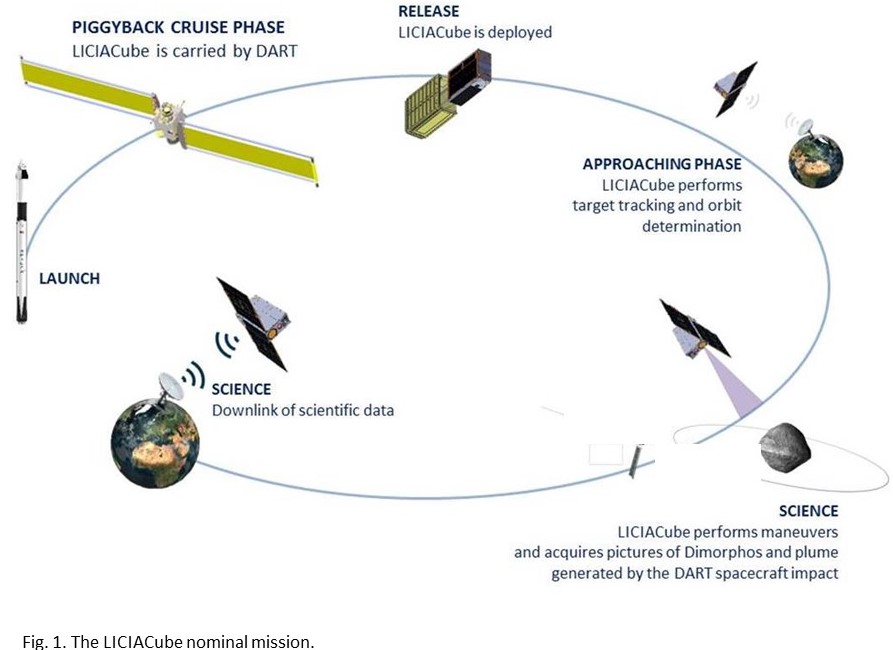
The LICIACube payload and observing strategy
The LICIACube mass is about 13 kg: it is developed by Argotec and equipped with two different payloads named LEIA and LUKE (Fig. 2).
LEIA (Liciacube Explorer Imaging for Asteroid) is a narrow FoV camera able to acquire images with a spatial scale close to 1.4 m/px at the minimum distance of about 55 km, while LUKE (Liciacube Unit Key Explorer) is a wide FoV imager with an RGB Bayer pattern filter.
LEIA and LUKE will offer the opportunity to obtain a unique science return, investigating for the first time the nature of a binary NEA. Comparing the impact and non-impact regions, as well as studying the nature and the evolution of the produced dust plume, will allow us to deeply investigate the composition and the structure of the material composing a small double NEA.
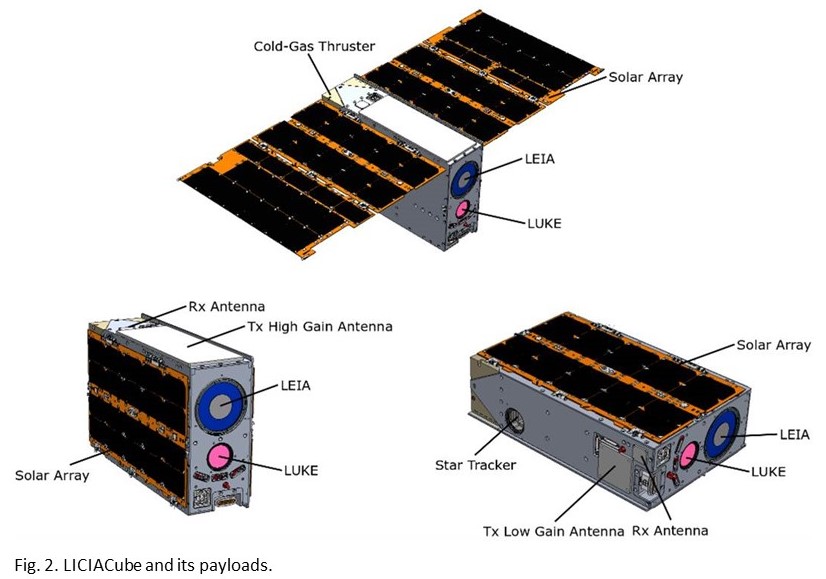
As a general approach each planned observation will be formed by a sequence of different images acquired at the maximum frame rate possible and possibly with different integration times.
Starting from about 45 s before T0, the nominal DART impact time, five different acquisition phases have been foreseen (Fig. 3). DART impact observation (red); Ejecta observation (yellow); High resolution observation of the surface properties and the crater (blue); Non-impact hemisphere observation (green); Plume evolution in forward scattering (purple).

Data Exploitation
The navigation radiometric data acquired during the scheduled tracking passes, along with the images collected before and during the encounter, will be used for an opportunity radio science experiment, to put constraints on the gravity of Didymos.
Images acquired by LEIA and LUKE will allow us to constrain the shape and volume of Dimorphos as well as its physical properties.
High-resolution images, obtained by LEIA at the closest approach, will allow us to study the surface morphology of Dimorphos and the presence of boulders/large blocks on its surface. By comparing pre- and post-impact surface areas we will have the unique opportunity to witness how the boulders size-frequency distribution and density changed as a result of the DART impact.
The LUKE data will give us also the opportunity to investigate the composition of Dimorphos throughout spectrophotometric analyses. So we will be able to map the surface composition of the object and to derive the surface heterogeneity at the observed scale.
The images of the plume, compared with numerical models of dust dynamics, will allow us to have measurements of the motion of the slow ejecta and to estimate the structure of the plume.
References.
Capannolo A., et al. (2021), Acta Astronautica, Volume 182, p. 208.
Cheng A. F., et al. (2018) PSS, 157, 104.
Dotto E., et al. (2021) PSS, 199, id. 105185
Rivkin A.S., et al. (2021) Planetary Science Journal, in press.
Zinzi A. et al. (2016) Astron. Comput., 15, 16-28.
Zinzi A. et al. (2019) EPSC-DPS Joint Meeting 2019, id. EPSC-DPS2019-1272.
Acknowledgements. The LICIACube team acknowledges financial support from Agenzia Spaziale Italiana (ASI, contract No. 2019-31-HH.0 CUP F84I190012600).
How to cite: Dotto, E., Della Corte, V., Amoroso, M., Bertini, I., Brucato, J. R., Capannolo, A., Cotugno, B., Cremonese, G., Di Tana, V., Gai, I., Ieva, S., Impresario, G., Ivanovski, S. L., Lavagna, M., Lucchetti, A., Mazzotta Epifani, E., Meneghin, A., Miglioretti, F., Modenini, D., and Pajola, M. and the LICIACube team: LICIACube – the Light Italian Cubesat for Imaging of Asteroid onboad DART, Europlanet Science Congress 2021, online, 13–24 Sep 2021, EPSC2021-160, https://doi.org/10.5194/epsc2021-160, 2021.
Abstract -The Jet Propulsion Laboratory (JPL) has been at the forefront of finding ways to deliver big science returns in small packages. This talk will describe the current state of missions and capabilities across the mission lifecycle from early concept formulation and implementation through on-orbit operations. From examining how we use concurrent engineering tools, processes and teams for the development of small instruments as well as complete missions, this talk will focus on expanding the capabilities of science using small spacecraft to enable missions for Planetary Science, Astrophysics, Heliophysics and Earth Science. Highlighted key technologies and science measurements will be described.
How to cite: Kahn, P.: The Current Status of JPL’s SmallSat Developments, Europlanet Science Congress 2021, online, 13–24 Sep 2021, EPSC2021-872, https://doi.org/10.5194/epsc2021-872, 2021.
In order to increase the scientific and technological return of the Artemis I mission, NASA has directed the SLS Program to accommodate Secondary Payloads on board of the Space Launch System (SLS), to be deployed with the Orion capsule; among them, ArgoMoon cubesat has been selected as European contribution. It is a 6U platform designed by Argotec on behalf of the Italian Space Agency (ASI) and will be released from the launch vehicle Interim Cryogenic Propulsion Stage (ICPS). The main objectives of the satellite are: i) taking photographs to document the ICPS after the deployment of the Orion capsule and the deployment of the other secondary payloads mounted on-board; ii) taking photographs of the Earth and the Moon; iii) validate guidance and autonomous targeting technology and iv) verifying a new technology for power distribution, satellite data acquisition and processing suitable for nanosatellite volume. In fact, the cubesat will be the first national spacecraft working in near Deep Space and operated through a Ground Segment mainly based in Italy.
ArgoMoon design is based on the HAWK platform, designed by Argotec following an “all in-house” concept. Some of the main features of this platform are the focus on rad-hard subsystem components, a high level of autonomy capability supported by artificial intelligence, and the scalability towards larger bus sizes.
Early after deployment, ArgoMoon will be able to operate autonomously and perform SLS tracking and proximity flight navigation, making use of a complex image recognition algorithm based on artificial intelligence. These operations are carried out by two optical payloads and the obtained photography will be used to support the NASA and payload communities in providing information regarding the status of their deployment and the condition of the second stage as it completes the final phase of its mission. After that, ArgoMoon will be operative for another six months for technological validation and Moon observation purposes.
During the communication windows throughout the entire satellite lifetime, ArgoMoon will be operated and monitored entirely by the Argotec Mission Control Centre, connected to the Deep Space Network (DSN). The Flight Control Team (FCT) will follow the flight operations with in-house developed software able to plan and validate in orbit activities, verifying the on-board.
After a successfully integration and test campaign, the cubesat has been shipped to USA for the filling activities on the propulsion tanks and the final delivery to NASA for the integration in the SLS, expected in July 2021.
The results of this mission will strongly contribute to future of Space Exploration based on small satellite platforms in Deep Space.
How to cite: Pirrotta, S., Cotugno, B., di Tana, V., Patruno, S., Ingiosi, F., and Simonetti, S.: ArgoMoon: the Italian cubesat for Artemis1 mission, Europlanet Science Congress 2021, online, 13–24 Sep 2021, EPSC2021-879, https://doi.org/10.5194/epsc2021-879, 2021.
Introduction
Astrobiology is an interdisciplinary field covered by only a few CubeSat missions so far. Moreover, no CubeSat mission has ever mounted miniaturized technology for the purpose of searching for molecular evidences of life in space.
AstroBio CubeSat (ABCS) is a 3U CubeSat selected by the European Space Agency (ESA) to be launched in spring 2022 with the Vega C maiden flight, as piggy back passenger of the ASI LARES2 mission. ABCS will host a payload assembly based on Lab-on-Chip (LoC) technology for biomarkers detection and will be deployed along a circular orbit with altitude of about 5900 km and inclination of 7°, therefore crossing the inner Van Allen belt where the radiation flux is close to its maximum. Due to the harsh environment, ABCS payload and subsystems will be likely exposed to damages and degradations of electronics and performances, thus the payload assembly and the operational architecture were designed to be as much dependable as possible. This approach should constitute the first step to implement a mature technology with the aim to check the stability of chemicals and biomolecules involved in space experiments.
This work reports an overview of ABCS architecture and the approach chosen for its operational design.
ABCS Architecture
ABCS objective is to test in space an automatic in-situ multiparameter LoC [1], which exploits luminol injection and enzymatic bio-mimicking assays on a functionalized 3D wax-printed origami. Luminol will be transported by capillarity to reaction sites with immobilized biomolecules targets where the reactions will trigger chemiluminescence, detected by means of hydrogenated amorphous silicon (a-Si:H) photodiodes deposited on a borosilicate glass substrate and connected to a photocurrent readout board [2]. The described payload consists in an experiment board hosting the LoC and a support board containing peristaltic pumps for luminol injection, drivers for pumps, radiation field effect transistors (RADFETs) and pressure/temperature sensors. The LoC architecture allows to repeat the experiment up to six times.
In addition to RADFETs, ABCS mounts an ancillary radiation dose sensor (ARDS), developed by Thales Alenia Space, with the aim to assess the radiation effects. The ARDS is able to measure different amounts of current, until its failure, depending on the dose acquired.
To mitigate the effects of the expected very high flux of charged particles, an extra tungsten layer shielding was mounted on each side panel and all the main subsystems (experiment and support board, batteries and EPS board, on-board computer (OBC), telemetry, tracking and control board), were placed inside a 5 mm thick aluminium box. At the same time, to keep the temperature range (from 4°C to 20°C) and operative pressure (about 1 atm) required to allow the LoC capillarity effect and to prevent reagents degradation, the box was sealed and a thermal control system, composed by a multi-layer insulation and an active heather mounted inside the box, was implemented.
ABCS Mission Design
ABCS will be deployed in an approximately circular orbit at about 5900 km altitude and 70° of inclination, spending a significant amount of the orbital period within the inner Van Allen belt, very close to its radiation peak point.
ABCS ground operations will be mainly performed from the School of Aerospace Engineering (SIA) Ground Station. Simulations show that SIA will have access to ABCS 4 times a day, with an average duration of about 65 minutes. For this reason, a network of radioamateurs and third part ground stations will be involved for supporting the collection of the telemetry and science data packages and possibly uplink commands.
ABCS Operations
The assumption we made is that ABCS should be able to perform the payload operations in a completely autonomous manner. As we know, radiation flux will most likely induce several errors on electronics and performances, causing potential mission failure due to the fact that payload operations may not start because the OBC fails to send the command to start the experiment. A possible way to reduce failure is to perform ABCS experiments where the proton flux is lower. Simulations shows that this happens when ABCS is at polar latitudes, namely outside the range [-60°; 60°]. For this reason, the payload operations, based on redundant checks and triggers, were implemented accordingly. The purpose is to automatically determine if ABCS is at a latitude useful to perform the experiments and verifying this condition by means of multiple triggers, time or position based. Each trigger is used for scheduling purposes only if the ones with higher priority are unreliable. If all the triggers are not reliable, payload operations are forced to begin, as it is better to perform eventually degraded payload operations rather than performing no payload operations at all.
Conclusions
ABCS is required to operate in an extremely harsh environment where radiation fluxes are likely to degrade the electronic devices. Operations should be scheduled in order to reduce the time needed to perform all the experiments. The chosen approach will lead ABCS to complete the payload operations in three orbital periods, reducing the total ionizing dose absorbed and guaranteeing the higher system reliability.
Acknowledgments
ABCS AstroBio-CubeSat is supported by ASI - Italian Space Agency ASI/INAF Agreement n. 2019-30-HH.0.
References
[1] Iannascoli, L. et al. 2020, "Astrobio cubesat: Enabling technologies for astrobiology research in space", Proceedings of the International Astronautical Congress, IAC.
[2] Mirasoli M, et al. 2014. Multiwell cartridge with integrated array of amorphous silicon photosensors for chemiluminescence detection: development, characterization and comparison with cooled-CCD luminograph. Anal Bioanal Chem. Sep;406(23):5645-56.
How to cite: Meneghin, A., Brucato, J. R., Paglialunga, D., Nascetti, A., Iannascoli, L., Poggiali, G., Carletta, S., Schirone, L., Pirrotta, S., Impresario, G., Pacelli, C., Anfossi, L., Mirasoli, M., Trozzi, I., Calabria, D., Popova, L., Bardi, A., and Balsamo, M.: AstroBio CubeSat: operational design of a CubeSat for astrobiological purposes in radiative environment, Europlanet Science Congress 2021, online, 13–24 Sep 2021, EPSC2021-174, https://doi.org/10.5194/epsc2021-174, 2021.
During its evolution, the Sun and its protective magnetic bubble – the heliosphere - has completed nearly twenty revolutions around the Galactic Core. During this “Solar Journey” it has plowed through widely different interstellar environments that have all shaped the system we live in today. The orders-of-magnitude differences in interstellar properties have had dramatic consequences for the penetration of interstellar material and have affected elemental and isotopic abundances, atmospheric evolution and perhaps even conditions for habitability. As far as we know, only some 60, 000 years ago, the Sun entered what we call the Local Interstellar Cloud (LIC), and in less than 1,900 years the Sun will be entering a very different interstellar environment that will continue to shape its evolution and fate.
The Interstellar Probe is a pragmatic mission with a possible launch already in the next decade that would explore the heliospheric boundary and how it interacts with the Very Local Interstellar Medium (VLISM) to understand the current state along this Solar Journey and, ultimately understand where our home came from, and where we are going. During its 50-year nominal design life, it would go far beyond where the Voyager missions have gone, out to about 400 astronomical units (au) and likely survive out to 1000 au. Therefore, the Interstellar Probe mission would represent humanity’s first explicit step in to the galaxy and become NASA's boldest step in space exploration.
When the Voyager missions traversed the heliospheric boundary with their very limited payload it became clear that we are faced with a whole new regime of space physics that is not only decisive for our own heliosphere, but also for understanding the physics of other astrospheres as well. Today we still do not understand the force that is upholding the magnetic shell (the heliosheath) around our heliosphere, or the mechanisms that shield the solar system from galactic cosmic rays, and many other mysteries. Once beyond where the furthest Voyager spacecraft will cease operations (likely at ~170 au), Interstellar Probe would step in to the unknown, traverse the hydrogen wall and the complex magnetic topology at the very edge of the Sun’s sphere of influence, and then directly sample for the first time the interstellar material that has made all of us. There, measurements of the unperturbed gas, plasma, and fields would allow accurate determination of the current state of the LIC and how it affects the global heliosphere. Measurements of unshielded interstellar dust and galactic cosmic rays would provide unprecedented information on stellar and galactic evolution. The physical processes that occur as the solar wind and magnetic field interact with VLISM would also provide the only directly measurable prototypes for understanding the astrospheres surrounding other stars that control the atmospheres and habitability of their exoplanets. All this newly acquired knowledge would then enable an understanding of the current state of the heliosphere and the VLISM, and how they interact, which ultimately can be used to extrapolate the understanding of our system back to the past and into the future.
At the same time, the outward trajectory is a natural opportunity for exploring one of the ~4,000 Kuiper Belt Objects or ~130 dwarf planets similar to and beyond Pluto and determine the large-scale structure of the circum-solar dust disk to provide the ground truth for planetary system formation in general. Once beyond the obscuring dust, the infrared sky would open a window to early galaxy formation.
An Interstellar Probe has been discussed and studied since 1960, but the stumbling block has always been propulsion. Now this hurdle has been overcome by the availability of new and larger launch vehicles. An international team of scientists and experts are now in the final year of a NASA-funded study led by The Johns Hopkins University Applied Physics Laboratory (APL) to develop pragmatic example mission concepts for Interstellar Probe with a nominal design lifetime of 50 years. Together with the Space Launch System (SLS) Program Office at NASA’s Marshall Space Flight Center, the team has analyzed dozens of launch configurations and demonstrated that asymptotic speeds in excess of 7.5 au per year can be achieved using existing or near-term propulsion stages with a powered or passive Jupiter Gravity Assist (JGA). These speeds are more than twice that of the fastest escaping man-made spacecraft to date, which is Voyager 1 currently at 3.59 au/year. Launching near the nose direction of the heliosphere, Interstellar Probe would therefore reach the Termination Shock (TS) in less than 12 years and cross the Heliopause into the VLISM after about 16 years from launch.
In this presentation we provide an overview and update of the study, the science mission concept, the compelling discoveries that await, and the associated example science payload, measurements and operations ensuring a historic data return that would push the boundaries of space exploration by going where no one has gone before.
How to cite: Brandt, P., McNutt, R., Provornikova, E., Kinnison, J., Lisse, C., Runyon, K., Rymer, A., Turner, D., Hill, M., Mostafavi, P., Cocoros, A., Mandt, K., Bale, S., Galli, A., DeMajistre, R., and Paul, M. and the The Interstellar Probe Study Team: Interstellar Probe: A Mission to Explore the Heliospheric Boundary and Interstellar Medium, Europlanet Science Congress 2021, online, 13–24 Sep 2021, EPSC2021-266, https://doi.org/10.5194/epsc2021-266, 2021.
Vast amounts of meteoroids and micrometeoroids continuously enter the Earth–Moon system and consequently become a potential threat. Lunar meteoroid impacts have caused a substantial change in the lunar surface and its properties. The Moon having no atmospheric blanket to protect itself, it is subjected to impacts from meteoroids ranging from a few kilograms to 10’s of grams each day. The high impact rate on the lunar surface has important implications for future human and robotic assets that will inhabit the Moon for significant periods of time. Therefore, a greater understanding of the meteoroid population in the cislunar environment is required for future exploration of the Moon.
Moreover, refining current meteoroid models is of paramount importance for many applications. For instance, since meteoroids may travel dispersed along the orbit of their parent body, understanding meteoroids and associated phenomena can be valuable for the study of asteroids and comets themselves. Studying meteoroid impacts can help deepening the understanding of the spatial distribution of near-Earth objects in the Solar system. The study of dust particles can be also of interest because, together with the solar wind, they determine the space weather. Finally, it is critical to be able to predict impacts by relying on accurate impact flux models. That because the impact of small asteroids with Earth, even slightly larger than meteoroids, can cause severe damage.
In this context, the Lunar Meteoroid Impacts Observer (LUMIO) is a CubeSat mission to observe, quantify, and characterise the meteoroid impacts by detecting their flashes on the lunar far-side. This complements the knowledge gathered by Earth-based observations of the lunar nearside, thus synthesising a global information on the lunar meteoroid environment. LUMIO envisages a 12U CubeSat form-factor placed in a halo orbit at Earth-Moon L2. The mission employs the LUMIO-Cam, an optical instrument capable of detecting light flashes in the visible spectrum. LUMIO is one of the two winner of ESA’s LUCE (Lunar CubeSat for Exploration) SysNova competition, and as such it is being considered by ESA for implementation in the near future. The Phase A study has been conducted in 2020 under ESA's General Support Technology Programme (GSTP) and successfully completed at the beginning of 2021, after an independent mission assessment performed by ESA’s CDF team.
In this work, the latest results of the Phase A study of the LUMIO lunar CubeSat will be shown. An overview of the present-day LUMIO CubeSat A design will be given, with a focus on the latest developments. An overview on how LUMIO will impact the currently existing knowledge of meteoroid models will be given supported by high-fidelity simulated data.
How to cite: Merisio, G., Franzese, V., Giordano, C., Massari, M., Di Lizia, P., Topputo, F., Labate, D., Pilato, G., Cervone, A., Speretta, S., Menicucci, A., Bertels, E., Woroniak, K., Kukharenka, A., Thorvaldsen, A., Koschny, D., Vennekens, J., and Walker, R.: LUMIO: a CubeSat to monitor the lunar farside, Europlanet Science Congress 2021, online, 13–24 Sep 2021, EPSC2021-282, https://doi.org/10.5194/epsc2021-282, 2021.
Deimos and Phobos are considered primary targets of investigation to understand the origin and evolution of Mars and more in general the terrestrial planets of the Solar System.
TASTE mission aims complementing MMX investigation by focusing on Deimos surface, combining both global remote sensing observations from a close orbit and direct in-situ analyses of the surface thanks to a lander release on Deimos. With a synergy between orbital and in-situ investigations, the proposed mission will contribute to the Deimos global morphology understanding; its global elemental abundance; landing site morphology and texture; landing site organic content and surface composition. TASTE is conceived as a Cubesat-in-Cubesat mission: a 12U space asset composed by a 9U orbiter and a 3U lander. The former embarks an X-gamma ray spectrometer developed by OAT and a multispectral camera, the second is equipped with a miniaturized Surface Sample Analyser (SSA), composed by a new Sample Acquisition Mechanism (SAM), conceived by PoliMi and a Surface Analytical Laboratory (SAL) developed by INAF OAA.
The mission is conceived to keep the orbiter on a QSO nearby Deimos to facilitate the lander release and the scientific operations in synergy with the lander itself. Details on science, space assets sizing and design and mission science operations will be discussed in deep.
How to cite: Lavagna, M., Brucato, J., Prinetto, J., Capannolo, A., Bechini, M., Zanotti, G., Fiore, F., Meneghin, A., Fornaro, T., Paglialunga, D., and Piazzolla, R.: the TASTE mission: In situ DEIMOS terrain analyzer with smalls and miniturized lander, Europlanet Science Congress 2021, online, 13–24 Sep 2021, EPSC2021-461, https://doi.org/10.5194/epsc2021-461, 2021.
Interstellar Probe is an ambitious mission concept, to reach interstellar space (up to 1000 AU). Its launch date is between 2030 and 2042 and its goals cover different fields of science from planetary science, heliophysics (heliosphere), to astronomy. One main goal is to significantly expand our knowledge about our heliosphere, the interstellar medium, and how both interact with each other. Among many other instruments, the space probe is planned to carry a dust mass spectrometer that will be able to capture dust particles and measure their composition. This will be especially useful for measuring the interstellar dust of the local interstellar medium that continuously streams through the solar system and has been directly detected for the first time with the Ulysses spacecraft in the 1990s. The mass distributions from such in situ dust detections in the solar system so far have shown a significant discrepancy compared to the results from astronomical observations. We performed a series of simulations of the interstellar dust trajectories and distribution inside the solar system and use them to predict the ability of the Interstellar Probe to measure interstellar dust particles and how this ability is affected by different spacecraft trajectories and dust detector setups. We also discuss how the filtering of small dust particles at the boundary regions of the heliosphere affects our predictions and indicate how in situ dust measurements can be used to constrain the filtering process. In general, most of the dust particles can be measured if the spacecraft moves towards the nose of the heliosphere. However, we also find a significant correlation between the presence of small dust particles (<0.3 microns) in the inner solar system and the phase of the solar cycle which is caused by the filtering effect of the solar magnetic field via the Lorentz force. Inside the heliosphere, the interstellar Probe may be able to detect and analyze up to 1 interstellar dust particle per day for particle sizes >0.1 micron and many more of the smaller particles, depending on the state of the solar magnetic field and the dust filtering at the boundary of the heliosphere. Outside the heliosphere, the absence of dust filtering should increase the detection rate of small particles (<0.1 microns) to more than 10 per day.
How to cite: Hunziker, S., Sterken, V., Strub, P., Krüger, H., and Li, A.: Opportunities for interstellar dust detection by the Interstellar Probe, Europlanet Science Congress 2021, online, 13–24 Sep 2021, EPSC2021-529, https://doi.org/10.5194/epsc2021-529, 2021.
Dust Astronomy investigates the nature and the origin of dust particles in space. The particle size distribution ranges from nanodust to approximately 100 micrometer. The study of the elemental and/or chemical composition of the particles together with the knowledge about their origin provides insights into many disciplines. Dust Astronomy is an interdisciplinary working field, which includes Solar System Science, Interstellar Medium studies and Astrobiology. A basic tool for these studies are Dust Telescopes.
Dust Telescopes are in-situ instruments to characterize individual dust particles by their velocity vector, size and composition. They are based on impact ionization used for time-of-flight compositional analysis and on charge induction for particle speed and size measurements.
In this sense, already the Cassini Cosmic Dust Analyzer (CDA) was a simple Dust Telescope, which successfully characterized the dust environment at Saturn. Now, future missions go even further. In the next years the missions DESTINY+, EUROPA and IMAP will launch. In this talk, a summary is given about the capabilities of Dust Telescopes with a focus on the DESTINY+ Dust Analyser (DDA). DDA is a medium size instrument with a target diameter of 26 cm. A two-axis articulation allows to track dust RAM directions. Larger Telescopes like the record breaking LAMA instrument, developed especially for the measurement of low interstellar dust fluxes, and the instruments for the probes IMAP and EUROPA are compared with DDA.
The paper will address questions about the detection of nanodust or, what is a good instrument approach for a Dust Observatory? What are the instrumental challenges for an Interstellar Probe?
How to cite: Srama, R., Sternovsky, Z., Kempf, S., Horanyi, M., Postberg, F., Krüger, H., Kobayashi, M., and Sterken, V.: Dust Telescopes for Dust Astronomy, Europlanet Science Congress 2021, online, 13–24 Sep 2021, EPSC2021-659, https://doi.org/10.5194/epsc2021-659, 2021.
ABSTRACT
Enceladus is a Saturn’s icy moon that possesses a sub-surface ocean and a complex geological activity, with implications for its potential habitability. Gravity investigations at Enceladus could provide information on its internal structure including the radial density distribution, gravity anomalies, ice shell thickness and properties of the sub-surface ocean (mean density). In the recent years it was proposed to use SmallSat companion missions, dedicated only to specific investigations, to complement the science observations of a traditional larger exploration spacecraft. This represents a promising option since SmallSats provide relatively low-cost and versatile platforms for scientific observations. To investigate Enceladus’ gravity a SmallSats companion mission is proposed. The mission concept foresees two SmallSats deployed in orbit around Enceladus by a main Saturn’s orbiter. The objective is to globally characterize Enceladus’ gravity field through radio science investigations based on the Satellite-to-Satellite Tracking (SST). The observables are generated and decimated on-board by the SmallSats and transmitted back to Earth for data analysis and gravity field reconstruction, using the main spacecraft as a relay. However, Saturn proximity to Enceladus lead to major orbital instabilities for scientific near polar orbits. Moreover, the great distance from the Sun is a major drawback for the SmallSats platforms. Therefore, a mission feasibility study has been conducted by analyzing three-body stable orbits, proposing different SmallSats system budgets and concept of operations, and finally, by performing a radio science experiment performance preliminary assessment.
ORBITAL ANALYSIS
Due to the third body perturbation exerted by Saturn, near polar orbits are then highly unstable with a characteristic impact times up to 3 days [1]. Therefore, even if such orbits are optimal for scientific observations, they are too risky to be considered in this case. Periodic stable solutions are then searched by studying the Circular Restricted Three Body Problem (CRTBP) based on Saturn, Enceladus and one SmallSat. The research was mainly focused on 3D long period stable solutions with maximized inclination to improve the gravity science experiment performance. The search algorithm is based on a dedicated differential corrector [2] and the stability of the solution is evaluated through an index equal to the maximum of the eigenvalues of the monodromy matrix. The preliminary research has found 207505 periodic stable solutions from a search grid of 8000000 initial conditions (with minimum altitude above Enceladus set to 50km for planetary protection purpose). Currently, no stable solutions have found with average inclination greater than 75 degrees, in accordance with other studies [2][3]. Moreover, it has been seen that stable solutions with lower altitude tends to have a smaller average inclination. An example of a potential optimal solution (chosen from a tradeoff between eccentricity, altitude, and inclination) is represented in Figure 1.
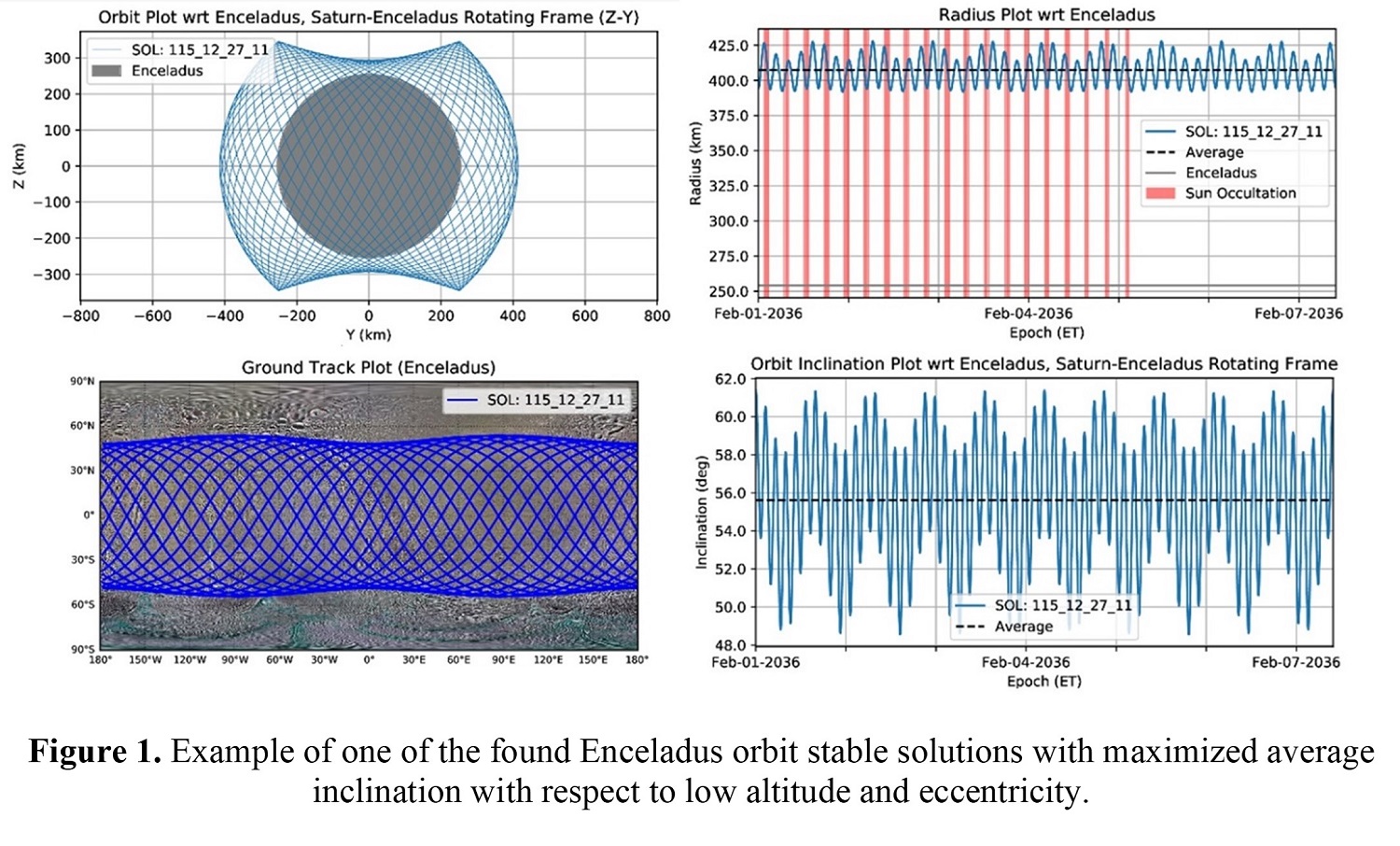
SYSTEM ANALYSIS
Two different mission concepts have been analyzed, both consisting of two 12U CubeSats performing SST while orbiting Enceladus. In the first mission concept, the feasibility of a short mission employing CubeSats relying solely on battery cells stored energy is explored. The second concept evaluates equipping the CubeSats with solar arrays to extend the mission duration. Since the solar flux at Enceladus is 100 times smaller than the one experienced in Earth orbit, the expected solar panels power output is so low that, in this latter concept, scientific observation phases needs to be alternated to CubeSats hibernation phases in which batteries are recharged. The SST payload features an S-band transceiver, two monopole antennas for RX/TX scientific operations and an S-band patch antenna coupled with an HPA for data relay to mothercraft. The raw data are preprocessed on board. The expected scientific data output is in the order of 300 kb/day accounting for ranging and doppler measurements. Due to strict planetary protection requirements, the two CubeSats are equipped with a camera for autonomous Optical Navigation and a green chemical hybrid propulsion system for station-keeping, orbital disposal and momentum unloading. Environment related constraints, as thermal control management and radiation environment are also evaluated and addressed.
RADIO SCIENCE EXPERIMENT PERFORMANCE
Orbital stability and system analysis provided solutions have been then injected to the radio science experiment performance preliminary assessment. The expected performances of the gravity field reconstruction were evaluated through multi-arc numerical simulations, using realistic assumptions on the noise level. The dynamical model is based on gravitation accelerations of all planets and Saturn’s satellites plus the Enceladus extended gravity field 50x50 simulated with Kaula’s Rule (K=1.3E-3)[4], and the Solar Radiation Pressure (SRP). The simulated measurements are Two-way S/S Doppler measurements between the SmallSats. The angular separation between the SmallSats has been set to 5 degrees, as it was found that higher angles are less effective for the experiment performance. Simulations results show the scientific phase duration to be the main performance driver for the experiment. Therefore, a comparison of the different scientific phase durations has been conducted (potential durations have been provided by the system budget analysis). An example of the results of the radio science experiment performance assessment for the stable solution of Figure 1 are presented in Figure 2. In the gravity spectra plot, the black line identifies the simulated gravity field, therefore when an uncertainty line goes above it then the maximum observable degree is depicted.
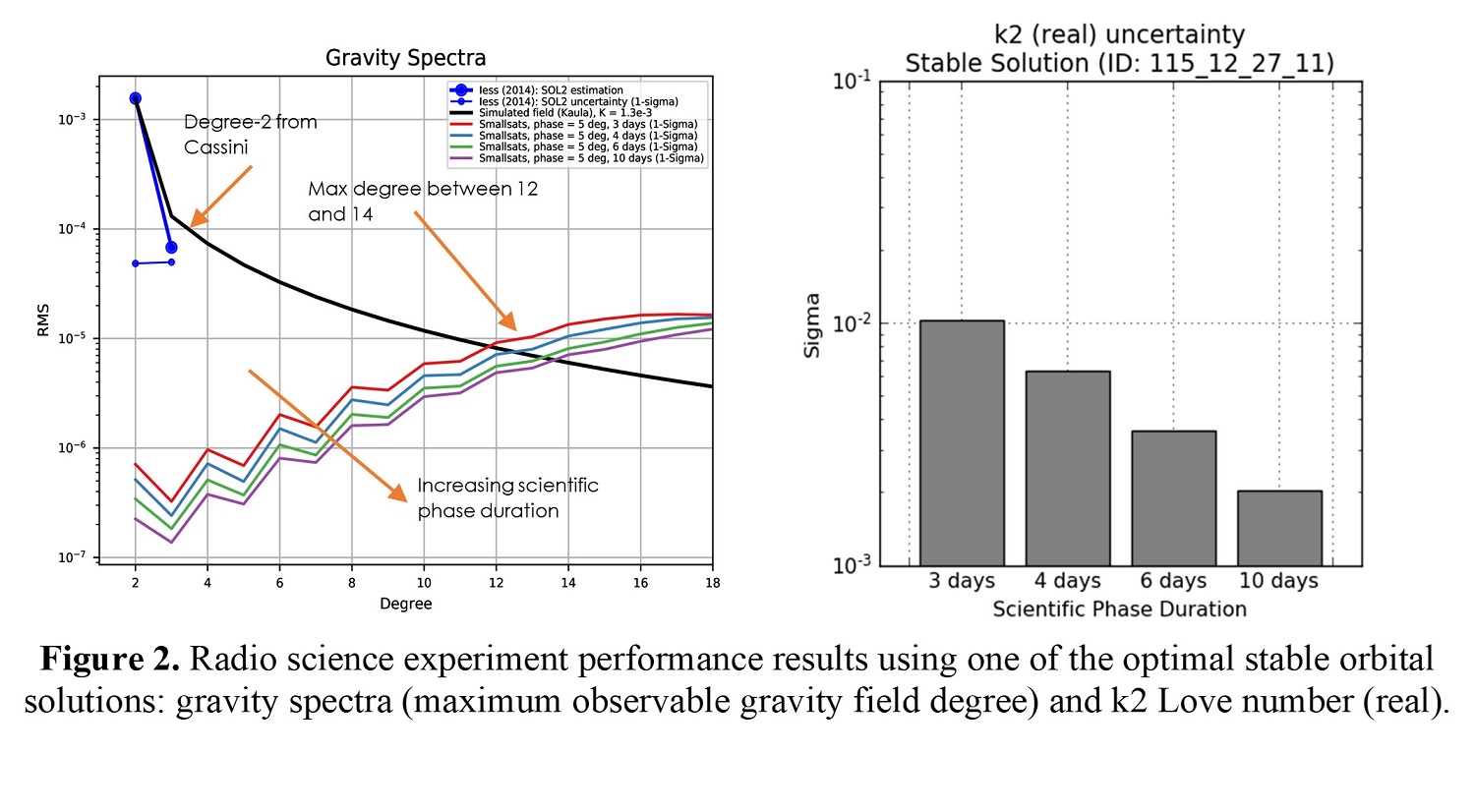
REFERENCES
- Russel, M. Lara, “On the Design of an Enceladus Science Orbit”, AIAA 2008-7072, 28 August 2008.
- Russel, “Global Search for Planar and Three-Dimensional Periodic Orbits Near Europa”, The Journal of the Astronautical Sciences, Vol. 54, No. 2, April–June 2006, pp. 199–226.
- S. Parker, R. L. Anderson, “LOW-ENERGY LUNAR TRAJECTORY DESIGN”, JPL, California, July 2013.
- Kaula, W, M., “Theory of Satellite Geodesy”, Blaisdell, Waltham, 1966.
How to cite: Lombardo, M., Strollo, E., Locarini, A., Lasagni Manghi, R., Modenini, D., Tortora, P., and Zannoni, M.: Enceladus Gravity Investigation using a SmallSat Mission, Europlanet Science Congress 2021, online, 13–24 Sep 2021, EPSC2021-780, https://doi.org/10.5194/epsc2021-780, 2021.
Polycyclic aromatic hydrocarbons (PAHs) are thought to play an important role as indicators for chemical processes in the interiors and on the surfaces of planets and moons. Based on the strength of the Unidentified Infrared Bands it is estimated that 10 –25% of all carbon in the ISM joins together to form the multi-ringed structure of PAHs [Tielens, 2008]. Therefore, this class of molecules is a ubiquitous and important tracer of chemical processes, which can be investigated with instruments on space exploration missions.
The ORganics Information Gathering INstrument (ORIGIN) is a prototype space instrument developed and built at the University of Bern, Switzerland, for the detection of biomolecules on planetary surfaces [Ligterink et al., 2020] [Riedo et al., 2013]. ORIGIN is Laser Ionization Mass Spectrometer (LIMS) operated at desorption conditions. A single 266 nm nanosecond laser pulse is used to desorb and ionize gently molecules from a steel sample surface, located in a vacuum chamber at a pressure of P<10-7 mbar. The ions are subsequently detected with a miniature reflectron-type time-of-flight mass analyser. The steel sample holder is placed onto an xyz-translation stage, which allows accurate positioning relative to the mass analyser and to analyse samples at multiple positions.
Four different PAHs were investigated in this measurement campaign: Anthracene (C14H10), Coronene (C24H12), Pyrene (C16H10), and Perylene (C20H12), which are representative of PAHs of different structures and sizes. These molecules are analysed at different average surface concentrations (0.1 – 700 picomol mm-2) and laser pulse energies (1-4 µJ).
Figure 1 shows the mass spectra of the four PAHs measured at 4 µJ, demonstrating for the first time ORIGINs' ability to detect these species. The instrument shows the highest sensitivity for Coronene and the lowest for Anthracene. Identifying peaks for Coronene, Perylene and Pyrene can be detected even at a pulse energy of 1 µJ. At a higher laser pulse energy of 3 µJ, surface concentrations as low as 0.14 picomol mm-2 could be detected in the case of Pyrene, indicating that the limit of detection is even lower. Fragmentation of the PAHs is simple and limited, which reduces isobaric interferences of these molecules in complex mixtures and makes their identification easier. Moreover, the observed PAH fragments do not overlap with signatures from amino acids investigated earlier [Ligterink et al., 2020], meaning that if both species are present a reliable identification is possible. Note that at elevated mass/charge ratios of beyond 400 broadened mass peaks are observed. The ion optical setup used for this campaign was optimised for peaks below a mass of 300 and will be improved for upcoming studies.
The result of this measurement campaign shows that ORIGIN can detect PAHs at low surface concentrations and different laser pulse energies. This further shows the capabilities of the instrument in analysing the composition of planetary surfaces, the results of which can be used to characterize the chemical environments.
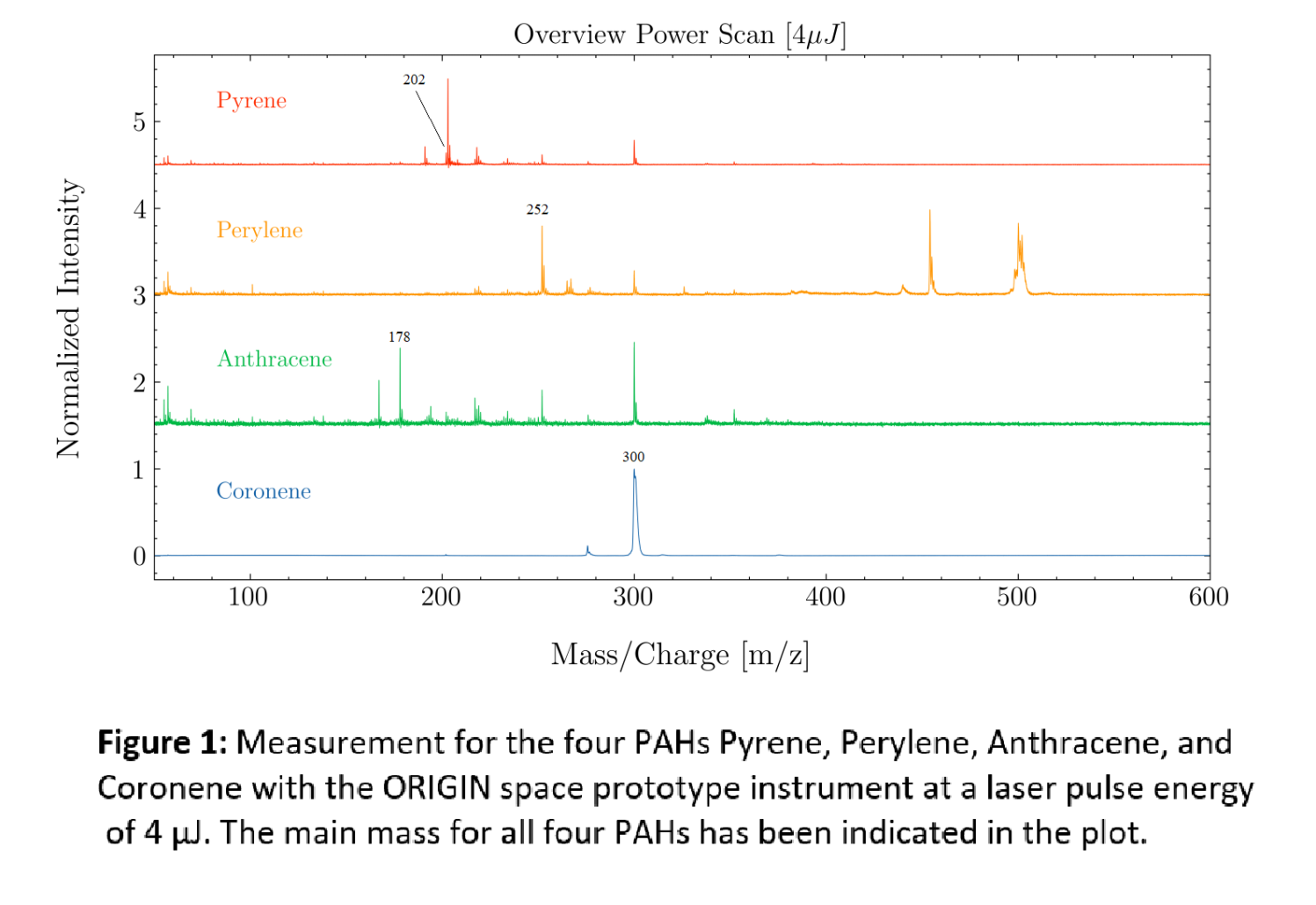
References:
Tielens, A.G.G.M. Interstellar polycyclic aromatic hydrocarbon molecules. Annual Review of Astronomy and Astrophysics, 46(1):289–337, 2008
Ligterink, N.F.W., Grimaudo, V., Moreno-García, P. et al. ORIGIN: a novel and compact Laser Desorption – Mass Spectrometry system for sensitive in situ detection of amino acids on extraterrestrial surfaces. Sci Rep 10, 9641 (2020).
Riedo, A. Bieler, M. Neuland, M. Tulej, and P. Wurz, Performance evaluation of a miniature laser ablation time-of-flight mass spectrometer designed for in situ investigations in planetary space research, J. Mass Spectrom., 48, 2013, 1 - 15
How to cite: Kipfer, K., Ligterink, N., Schwander, L., de Koning, C., Keresztes Schmidt, P., Grimaudo, V., Lukmanov, R., Tulej, M., Bouwman, J., Riedo, A., and Wurz, P.: Towards detecting carbon chemistry on planetary objects with the ORIGIN space instrument, Europlanet Science Congress 2021, online, 13–24 Sep 2021, EPSC2021-711, https://doi.org/10.5194/epsc2021-711, 2021.
Icarus is a mission concept designed to record the activity of an asteroid during a close encounter with the Sun. The primary science goal of the mission is to unravel the nontrivial mechanism(s) that destroy asteroids on orbits with small perihelion distances. Understanding the destruction mechanism(s) allows us to constrain the bulk composition and interior structure of asteroids in general. The Icarus mission does not only aim to achieve its science goals but also functions as a technical demonstration of what a low-cost space mission can do. The proposed space segment will include a single spacecraft capable of surviving and operating in the harsh environment near the Sun. The spacecraft design relies on the heritage of missions such as Rosetta, MESSENGER, Parker Solar Probe, BepiColombo, and Solar Orbiter. The spacecraft will rendezvous with an asteroid during its perihelion passage and records the changes taking place on the asteroid’s surface. The primary scientific payload has to be capable of imaging the asteroid’s surface in high resolution using visual and near-infrared channels as well as collecting and analyzing particles that are ejected from the asteroid. The payload bay also allows for additional payloads relating to, for example, solar research. The Icarus spacecraft and the planned payloads have high technology readiness levels and the mission is aimed to fit the programmatic and cost constraints of the F1 mission (Comet Interceptor) by the European Space Agency. Considering the challenging nature of the Icarus trajectory and the fact that the next F-class mission opportunity (F2) is yet to be announced, we conclude that Icarus is feasible as an F-class mission when certain constraints such as a suitable launch configuration are met (e.g., if EnVision is selected as M5). A larger mission class, such as the M class by the European Space Agency, would be feasible in all circumstances.
How to cite: Granvik, M., Lehtinen, T., Bellome, A., and Sánchez, J.-P.: Icarus: In-situ monitoring of the surface degradation on a near-Sun asteroid, Europlanet Science Congress 2021, online, 13–24 Sep 2021, EPSC2021-768, https://doi.org/10.5194/epsc2021-768, 2021.
Introduction:
The COMET INTERCEPTOR mission will perform an encounter with a Dynamically New Comet (DNC) and with its three spacecraft (S/C A, S/C B1 and S/C B2) will study different aspects of the comet (tail, nucleus, and atmosphere) with a multi-point approach. DISC (Dust Impact Sensor and Counter) is an instrument, on board the spacecraft A and B2 of COMET INTERCEPTOR, devoted to the analysis of comet dust particles mass properties. Here is presented an analysis of the instrument measurement performances, applying numerical simulations with ANSYSTM and AUTODYNTM platforms, to simulate sensing element mechanical behaviour. The particle impacts against the instrument sensing element are identified as HVI (Hypervelocity Impact). The dedicated modelling approach is based on a simulation chain based on the three-dimensional smooth-particle hydrodynamics (SPH) and Finite Element (FE). This chain was developed to gain an insight into characteristics of HVI-induced AE (Acoustic Emission) propagation inside the instrument.
Instrument working principle
DISC (Fig 1) consists of a single aluminium box containing the electronics and the sensing plate located on the top side of the box. The sensitive element consists of 3 zirconate piezoelectric sensors (PZT), glued at the corners of a 0.5 mm thick aluminium plate forming a 100 x 100 mm2 sensitive area. DISC aims to determine: dust mass distribution; dust particle count; dust impact duration; dust density/structure; dust coma structures.
Figure 1: DISC
Modelling Shock Waves Under HVI- Principles:
Combining particle-based SPH and element-based FE is a balanced model configuration to guarantee both calculation efficiency and accuracy. SPH can well characterize the large material distortion and compression induced by HVI. Nevertheless, discretizing the entire model with SPH will lead to an enormous effort spent on calculation. Hence, SPH is only applied to the region with large material distortion and compression (near the impact), and FE is introduced for the discretization of the region with a linear elastic response.
In SPH, the investigated structure is discretized into particles and there is no fixed connection between any two particles. The integral representation of a function (e.g., displacement) at particle i is approximated, in terms of its neighbouring particles in a support domain Ω. At each step of calculation, updated neighbouring particles for particle i are searched first (because material undergoes extreme deformation during HVI and Ω may involve different numbers of particles at each step) and then the computation is carried out based on the updated Ω.
Because HVI makes part of the target structure behave like a fluid and go through high compression, modelling of wave propagation in the target structure lies on the Navier–Stokes (NS) equation in this approach.
Equation of state (EOS), strength model, and failure criterion were introduced to the modelling as a supplement to NS equations.
Simulations Chains:
Starting from the theory explained, the analysis of instrument capability was conducted, by involving the ANSYSTM and AUTODYNTM platforms.
To obtain accurate results, but within a reasonable computational time, the effect of a particle impact on the sensing element of DISC test is simulated through a sub-simulations system, shown below:
1. Explicit dynamics analysis + Autodyn Tool (integration time 0 -> 1E-6 s): simulation involving the SPH part, settled before (Fig 2), and a FE discretize “stripe” (Fig 3) of the plate, aimed at saving the behaviour at the boundaries between SPH particles and FE elements, in terms of stress, deformation and velocity (Fig 4);
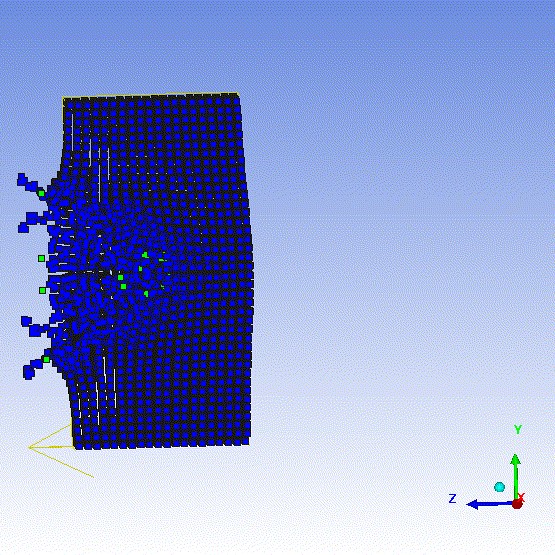
Figure 2: SPH plate after the HVI in the pre-simulation aimed at the model set. The SPH part is dimensioned such that the material behaviour at the surrounding FE area is elastic.
Figure 3: SPH discretized part + FE surrounding stripe.
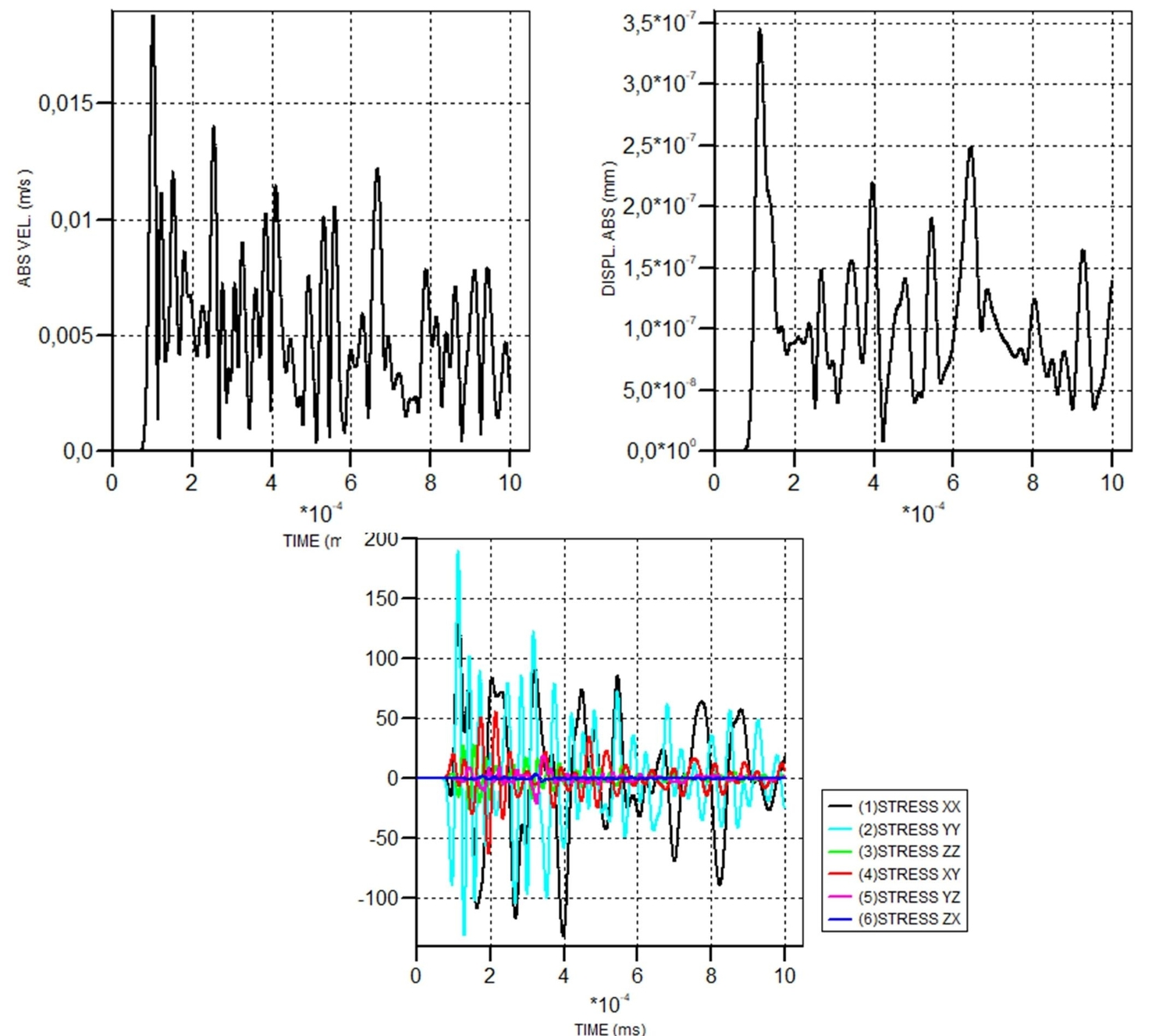
Figure 4: Velocity (upper left), Deformation (upper right) and Stresses (lower) graphs relative to a node at the boundary between SPH and FE part.
2.Transient structural analysis (integration time 0 -> 1E-6 s): the output of the previous analysis is used as input in this simulation, which includes, differently from the previous, the entire sensible plate. In this phase it is possible to obtain the effects of the HVI impacts at the plate edges;
3.Transient structural analysis (integration time 1E-6 -> 3e.4 s): again, the output of the previous analysis is used as input in this simulation, aimed at following the mechanical behaviour of the sensing element during the measurement (Fig 5);
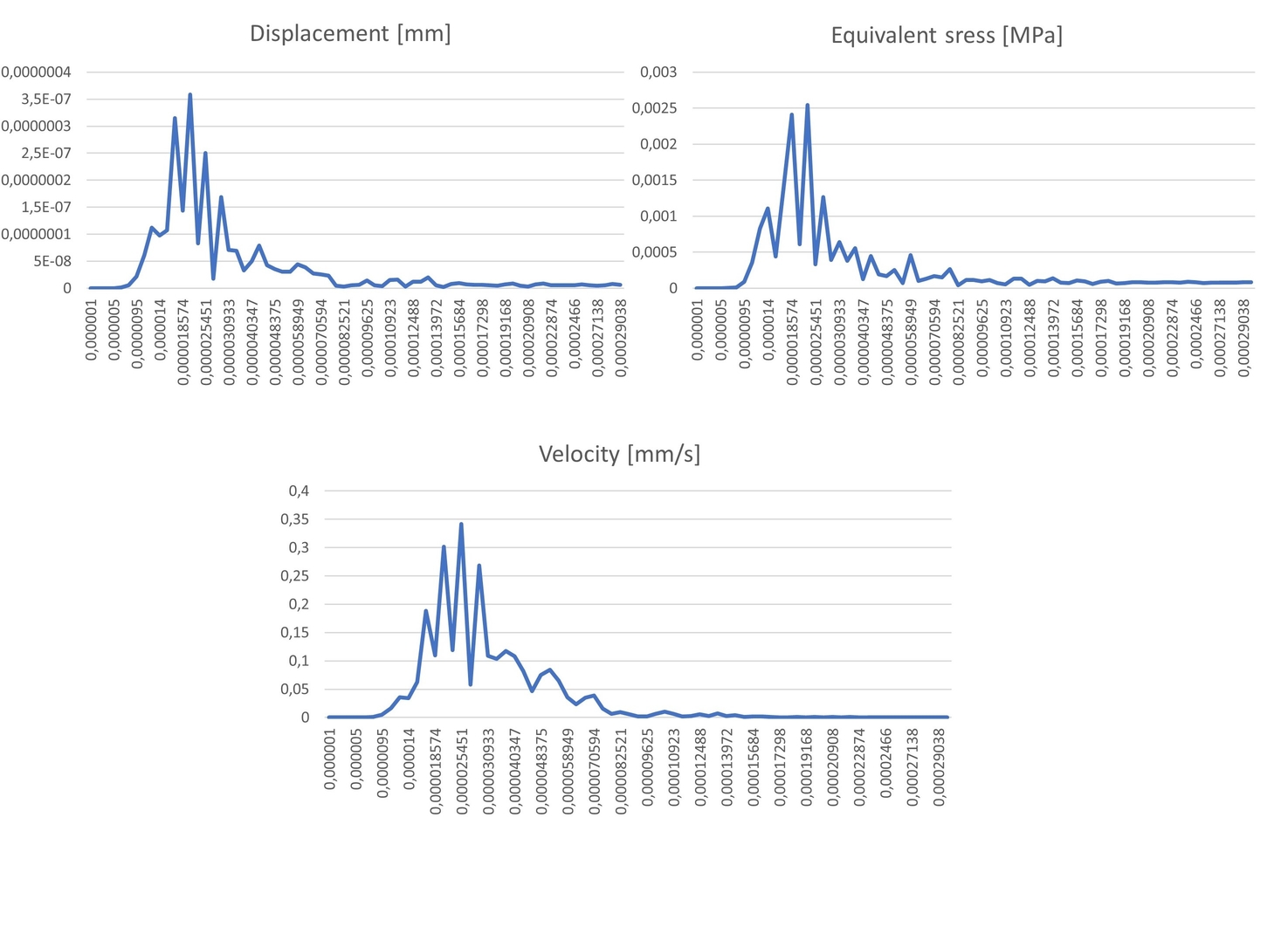
Figure 5: Displacement (upper left), Stress (upper right) and Velocity (lower) relative to a node in correspondence of a PZT.
4. Transient Structural analysis + PZT Module (integration time 0 -> 3e.4 s): same simulation setting of the previous one, plus four PZT sensors positioned at the edges of the sensible plate aimed at computing the voltage.
In this work preliminary results, showing the full simulation of the DISC sensing part (from impacting particle to PZT signal), are presented.
Acknowledgements: This research was also supported by the Italian Space Agency (ASI) within the "Partecipazione italiana alla fase 0 della missione ESA Comet Interceptor " (ASI-INAF agreement n.Accordo Attuativo" numero 2020-4-HH.0 ).
How to cite: Piccirillo, A. M., Della Corte, V., Rotundi, A., Inno, L., Longobardo, A., Di Paolo, F., Ferraioli, G., and Zakharov, V.: DISC-Modelling and Simulation chain of Hypervelocity Impacts, Europlanet Science Congress 2021, online, 13–24 Sep 2021, EPSC2021-618, https://doi.org/10.5194/epsc2021-618, 2021.
A mission that traverses through our solar system, past the boundaries of our heliosphere, and out of our habitable astrosphere to the very local interstellar medium (VLISM) provides a unique opportunity for various in-situ and remote observations during this long journey. The Interstellar Probe mission concept explores a near term, pragmatic basis for designing such a mission, prioritizing critical science measurements while identifying and working with the engineering constraints that come with a long duration mission operating far away from Earth. One of the many challenges of such a mission is selecting instrumentation that will collectively meet science requirements over a long baseline. In order to accomplish this, a variety of instruments will be need to be included in the payload, while keeping in mind size, mass, and power constraints for the mission. These may include particle and field sensors, imaging spectrometers, spectrographs, mass spectrometers, and dust analyzers.
Magnetometers (MAG), placed on a boom away from the spacecraft, will be one of the most critical instruments in the payload. With the exception of composition analysis and particle detection, magnetometers are capable of answering many questions related to the nature of the heliosphere, VLISM, and interactions between the two. While both vector helium magnetometers and fluxgate magnetometers have heritage, due to the lengthy duration of this mission fluxgates may provide a more reliable instrument.
Another set of critical instruments will be a particle suite that covers a wide range of energies. Particle sensors will play a key role in learning more about our heliosphere and VLISM, providing insight into everything but the neutral hydrogen wall. The suite would most likely include four sensors. First, a plasma system (PLS) would detect thermal ions and electrons up through light pick-up ions (PUI) with energies in the 10s-10000s eV. Detecting energetic ions, electrons, inner source PUIs, and PUI in the ISM would require an energetic particle system and dedicated pick-up ion instrument (EPS and PUI) for particles with energies 10s-1000s keV. A cosmic ray system (CRS) would account for the highest energy particles, observing anomalous cosmic rays (ACRs) and galactic cosmic rays (GCRs) with energies most likely ranging from 1-1000 MeV. Each of these systems would need as close to full coverage of the sky as possible, most likely achieved through angular coverage provided by a spinning spacecraft.
The final particle and field sensor that might be included on such a mission is a plasma wave instrument (PWI). This would support measurements made by the magnetometers and particle suite, enabling a better understanding of the size and shape of the heliosphere, particle acceleration in shock regions and the heliosheath, the structure and nature of the heliopause, and properties of the VLISM and GCR spectra outside the heliopause. While the measurements would most likely be made with four components spaced 90° from each other, all perpendicular to ram direction, determining the length and type of antenna used for this instrument is a trade between plasma wave science, guidance navigation and control capabilities, and mission operations.
Another critical sensor suite would involve energetic neutral atom (ENA) imagers, where the suite might include one or more imagers designed to image at different energy levels (the low energy ENA-L at 10-2000 eV, medium energy ENA-M at 0.5-15 keV, and high energy ENA-H at 1-100 keV). ENA imagers would result in a better understanding of the force balance and ENA ribbon, as well as solar/heliosphere/VLISM interaction and influence on each other. In particular, an ENA-H that has the capability to point back at our heliosphere once we are well into the VLISM would allow scientists to gain insight into what our astrosphere looks like from the outside. While the two lower energy ENA imagers would only require noseward hemisphere angular coverage, in order to perform the study of the heliosphere from the outside the ENA-H would need full sky coverage with a sun exclusion zone.
A neutral mass spectrometer (NMS) would provide key compositional insight during the mission by measuring neutral gas and dust in the VLISM, as well as the neutral hydrogen wall and neutral ISM gas and dust inside the heliosphere. Direct measurements of elemental and isotopic gas compositions of the VLISM would place an important constraint on models of stellar nucleosynthesis which holds implications for the formation of matter in the galaxy. This would enable a much better understanding of the properties and potential history of the ISM as a whole. The instrument would be placed facing the ram direction. Co-boresighted to perform complementary measurements to the NMS would be an Interstellar Dust Analyzer (IDA), which would further establish properties of the VLISM and how it affects our heliosphere. It would also provide important insight into the formation of planetary systems through the examination of interplanetary dust.
There are additional choices that could augment these core instruments, including a Lyman-alpha spectrograph (LYA) to provide vital information about interplanetary and VLISM hydrogen phasespace density, imaging spectrometers in the ultraviolet/visible/infrared (UVS/VIR) to study planet formation in the solar system by examining the debris disk and potential nearby Kuiper Belt objects and dwarf planets, and a visIR spectral mapper (IRM) to observe the diffuse red-shifted light emitted by the universe beyond the dominant Zodiacal cloud foreground that obfuscates such studies when performed within our heliosphere.
Taking the science objectives into account along with size, mass, and power constraints, two example payloads were developed for the Interstellar Probe concept study: one baseline payload which focuses on heliophysics objectives and an augmentation payload which accommodates a visNIR imager and the visIR mapper for performing a dwarf planet flyby and studying the extragalactic background light in addition to core heliophysics instrumentation. This presentation provides an overview of these example payloads, their accommodation on the spacecraft, and reliability issues associated with requiring up to 50 years of functionality.
How to cite: Cocoros, A., McNutt, R., Brandt, P., Kinnison, J., Jaskulek, S., Fountain, G., Smith, C., Mandt, K., Provornikova, E., Lisse, C., Runyon, K., Rymer, A., and Paul, M.: Instrumentation Solutions and Constraints for a Long Duration Interstellar Probe Mission, Europlanet Science Congress 2021, online, 13–24 Sep 2021, EPSC2021-392, https://doi.org/10.5194/epsc2021-392, 2021.
From Pioneer 10 to Juno, which is still active, several missions and space observatories have studied Jupiter’s atmosphere. Complementary, although limited by the telluric bands of water vapor, ground-based observations continue providing information about its vertical structure and its distribution around the planet. The main chemical composition of Jupiter’s atmosphere has been unraveled but lots of questions still remain open, such as the global abundance of water, the responsible chemistry for the coloration of the clouds, or what drives the aurora [1-2]. Moreover, observations by NIMS/Galileo [3-4] and VIMS/Cassini [5], have demonstrated the remarkable potential of VIS-NIR spectrometry for characterizing the composition and dynamics of planetary atmospheres [6].
The Moons And Jupiter Imaging Spectrometer (MAJIS) instrument is part of the science payload of the ESA L-Class mission JUICE (Jupiter ICy Moons Explorer) [7] to be launched in 2022 with an arrival at Jupiter in 2031. MAJIS combines two spectral channels able to cover the 0.5 – 2.35 μm range (VIS-NIR channel) and the 2.25 – 5.54 μm range (IR channel) [8]. As part of its scientific objectives, MAJIS will investigate the composition, structure, dynamics and evolution of Jupiter’s atmosphere at different levels, trace tropospheric cloud features, and characterize major and minor species, aerosols properties, and hot spots [9]. As explained by Langevin et al. [9], the spectral resolving power of MAJIS exceeds by three times that of NIMS or VIMS, with a spatial resolution four times better than NIMS, so it will efficiently track tropospheric processes such as clouds and hazes. Moreover, the close to equatorial orbit of JUICE for most of the mission will provide a comprehensive coverage of Jupiter in local time complementary to JIRAM/Juno [9].
We are interested in the scientific analysis of the MAJIS observations regarding the composition of Jupiter’s atmosphere, specifically on the H2O and CH4 contents, which are the most abundant species in the troposphere as a whole, after H2 and He [1]. Although it is expected that water vapor has a higher global volume mixing ratio than CH4 in the deep troposphere, this has yet to be observed [1]. Additionally, the strong spectral features due to crystalline water ice (1.5 µm and 2.0 µm) require a large abundance of water to be explained [10]. Therefore, we would like to perform simulations of different test cases with respect to the viewing geometries of MAJIS and the technical properties of its Flight Model VIS-NIR detector [11].
To proceed, we need to adapt the Radiative Transfer code developed at the Belgian Institute for Space Aeronomy (BIRA-IASB), ASIMUT-ALVL. It has been extensively used to characterize Mars and Venus atmospheres [12-19]. This tool is able to perform forward model simulations and atmospheric spectrum retrievals in nadir and limb geometries. To apply it to Jupiter’s atmosphere, some changes need to be done, such as implementing Jupiter’s physical parameters and adding the Rayleigh scattering contribution due to the dominant atmospheric species H2 and He. A more demanding modification to the code concerns the treatment of the Collision-Induced Absorption (CIA) due to H2-H2 and H2-He molecular systems.
A typical atmosphere’s vertical structure of Jupiter has been retrieved from [20-21]. The molecular line-lists and cross-sections have been implemented from the HITRAN online database with line parameters adequate for an H2-dominant atmosphere. Additionally, the microphysical parameters of the clouds and aerosols have been obtained from [22]. The different contributions to the spectra are being identified then simulated and finally validated through comparison with previous works [20-21]. This methodology ensures that each radiative contribution is well-understood and correctly implemented into ASIMUT-ALVL before assessing the performances of the MAJIS VIS-NIR channel to characterize the vertical structure of the Jovian atmosphere.
In this presentation, we will describe the different contributions and the challenges we faced for their implementation. A preliminary sensitivity analysis of MAJIS VIS-NIR will be discussed.
Acknowledgments
This project acknowledges the support of M. López-Puertas and the funding provided by the Scientific Research Fund (FNRS) through the Aspirant Grant: 34828772 MAJIS detectors and impact on science.
References
[1] Mc Grath, M.A., et al., Ed. 2004, Cambridge University Press, p. 59-77.
[2] MAJIS Team, JUICE Definition Study Report, 2014.
[3] Irwin, P.G.J., et al. Icarus, 2001. 149(2): p. 397-415.
[4] Baines, K.H., et al. Icarus, 2002. 159(1): p. 74-94.
[5] Brown, R.H., et al. Icarus, 2003. 164(2): p. 461-470.
[6] Langevin, Y., et al., Lunar and Planetary Science Conference, 2014.
[7] Grasset, O., et al., Planetary and Space Science, Vol. 78, pp. 1-21, 2013.
[8] Guerri, I., et al., International Society for Optics and Photonics, Vol. 10690, 2018.
[9] Langevin, Y., et al., EPSC, 2013. P. EPSC2013-548-1.
[10] Grassi, D., et al., Journal of Geophysical Research: Planets, 2020. 125.4: e2019JE006206.
[11] Cisneros-González, M. E. et al., Space Telescopes and Instrumentation in Proc. SPIE 2020, 11443, 114431L.
[12] Montmessin, F., et al. Icarus, 2017. 297: p. 195-216.
[13] Vandaele, A.C., et al. Optics Express, 2013. 21(18): p. 21148.
[14] Vandaele , A.C., et al. Adv. Space Res., 2016. 57: p. 443-458.
[15] Vandaele , A.C., et al. Icarus, 2016. 272: p. 48-59.
[16] Vandaele, A.C., et al. Icarus, 2017. 295: p. 1-15.
[17] Vandaele, A.C., et al. Planet. Space Sci., 2015. 119: p. 233-249.
[18] Neefs, E., et al., Applied Optics, 2015. 54(28): p. 8494-8520.
[19] Robert, S., et al., Planet. Space Sci., 2016. 124: p. 94-104.
[20] López-Puertas, M., et al., The Astronomical Journal, 2018. 156.4: 169.
[21] Guerlet, S., et al. Icarus, 2020. 351: 113935.
[22] Montañés-Rodríguez, P., et al., The Astrophysical Journal Letters, 2015, vol. 801, no 1, p. L8.
How to cite: Cisneros González, M. E., Robert, S., Erwin, J., Vandaele, A. C., Lauzin, C., Poulet, F., and Piccioni, G.: Simulating spectra of Jupiter’s atmosphere based on MAJIS VIS-NIR characteristics, Europlanet Science Congress 2021, online, 13–24 Sep 2021, EPSC2021-764, https://doi.org/10.5194/epsc2021-764, 2021.
1. Introduction
The Jovian Neutrals Analyzer (JNA) was developed as part of the Particle Environment Package (PEP), a suite of particle instruments onboard the JUpiter ICy moon Explorer (JUICE) spacecraft. JUICE will visit the Jovian system in the early 2020s to perform detailed observations of Jupiter’s icy moons and their complex interaction as a whole [1]. Part of this complex interaction can be probed through the remote observations of Energetic Neutrals Atoms (ENA).
The Jovian Neutrals Analyzer was designed to detect low-energy ENAs produced in the Jovian system by charge exchange in the Io plasma torus, as well as when co-rotating plasma impacts the icy surfaces of Jupiter’s moons. JNA was designed, developed and calibrated at the Swedish Institute of Space Physics in Kiruna. Here we report on the performance of JNA based on the results from the calibration campaign of the JNA Flight Model.
2. Instrument design
JNA’s design takes heritage from ENA instruments such as CENA on Chandrayaaan-1 and ENA on Bepi-Colombo [2, 3] and uses the same measurement principle: (1) ENAs enter the instrument through a set of collimator blades and are converted to ions upon impact on a conversion surface (polished Si surface coated with Al2O3). (2) ions are energy-analyzed using a wave energy analyzer, which also guides the ions into the Time-of-Flight (TOF) cell where (3) the speed of ions is measured. The TOF cell comprises of a start surface on which the converted ion hits: upon impact, a secondary electron is generated and detected by a Channel Electron Multiplier (CEM). The original particle is detected by a second CEM, and the time difference between those two detections is used to derive the speed of the original particle.
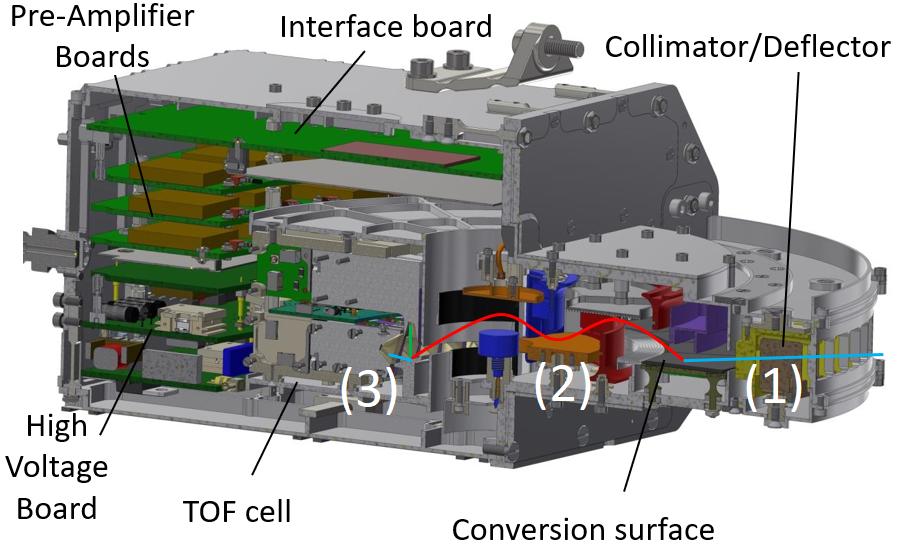
Figure 1. Longitudinal cut of a 3D model of JNA. Numbers in white indicate the 3 different steps of an ENA measurement.
JNA’s design improves on CENA and ENA by providing a better angular resolution, with 11 pixels instead of 7.
Those 11 pixels are arranged in a fan-like fashion (see Fig. 2), giving JNA a geometrical field-of-view of 150° in azimuth, and are each comprised of two CEMs. The use of CEMs (instead of MCPs as on CENA and ENA) provides a better mitigation of radiation-induced noise and was motivated by the harsh radiation environment expected at Jupiter.
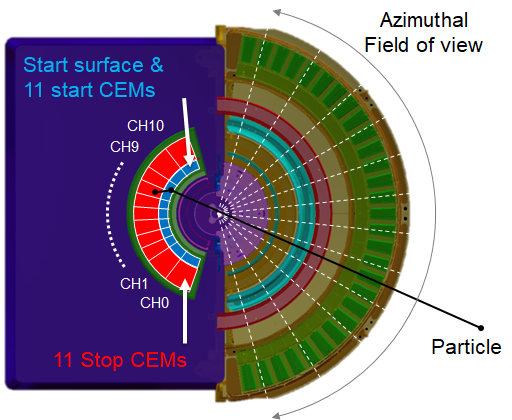
Figure 2. Schematic of JNA
3. Calibration procedure
JNA was calibrated at the calibration facility of the Swedish Institute of Space Physics in Kiruna, Sweden. The calibration facility includes a vacuum chamber equipped with an ion beam line a 4-axis turntable.
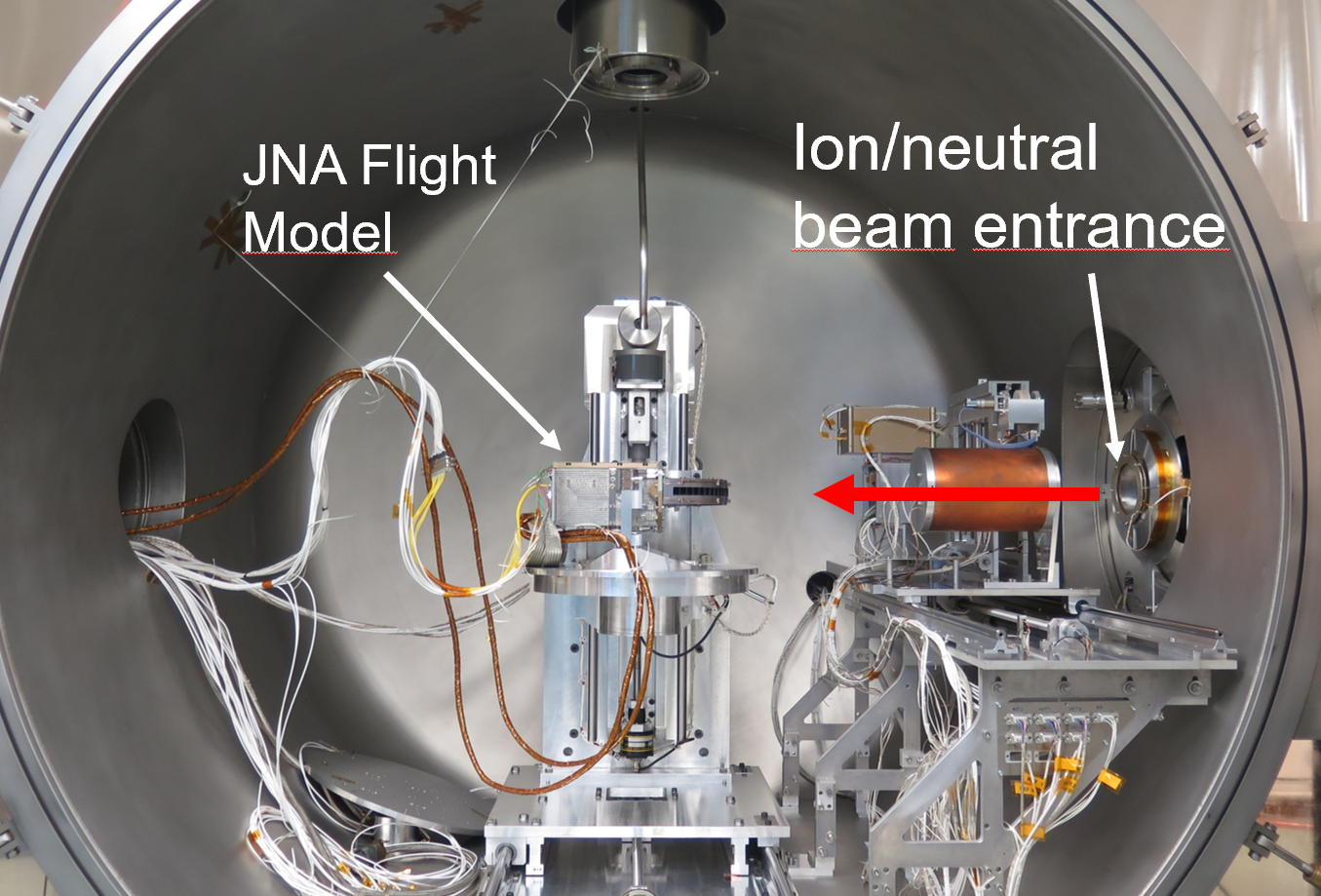
Figure 3. JNA Flight Model in the calibration facility at IRF-Kiruna.
During the main part of the calibration campaign, JNA was placed in the centre of the vacuum chamber on the 4-axis turntable and exposed to a low-energy neutral beam produced by charge-exchange between the ion beam and the residual gas present in the chamber. The ion beam species used included H, H2, H2O, N and Ar. Beam energies were varied from 150 eV to 3.3 keV.
At the end of the campaign, the voltage applied to JNA’s ion deflector was progressively lowered to verify the efficiency of the deflector. Finally, JNA was exposed to a radiation source to investigate the noise produced by penetrating radiation, expected to be significant at Jupiter.
4. Initial results
| Energy resolution (ΔE/E) | 100% |
| Mass resolution | H, Heavy |
| Mass range | 1-40 amu |
| Angular resolution | 15°-22° |
Table 1. JNA performance based on preliminary analysis of JNA Flight Model calibration data
Table 1 shows JNA performance specifications derived from a preliminary analysis of calibration results. JNA was found capable to resolve H from heavier neutrals with an energy resolution of 100%. Calibration measurements with Ar showed that JNA can measure up to at least 40 amu. Angular scans of the neutral beam showed that JNA’s mean angular resolution in azimuth ranges from 15° for center pixels to 21° depending on the pixel.
JNA was delivered to the European Space Agency in 2020 and is currently integrated on the JUICE spacecraft, planned for launch in September 2022.
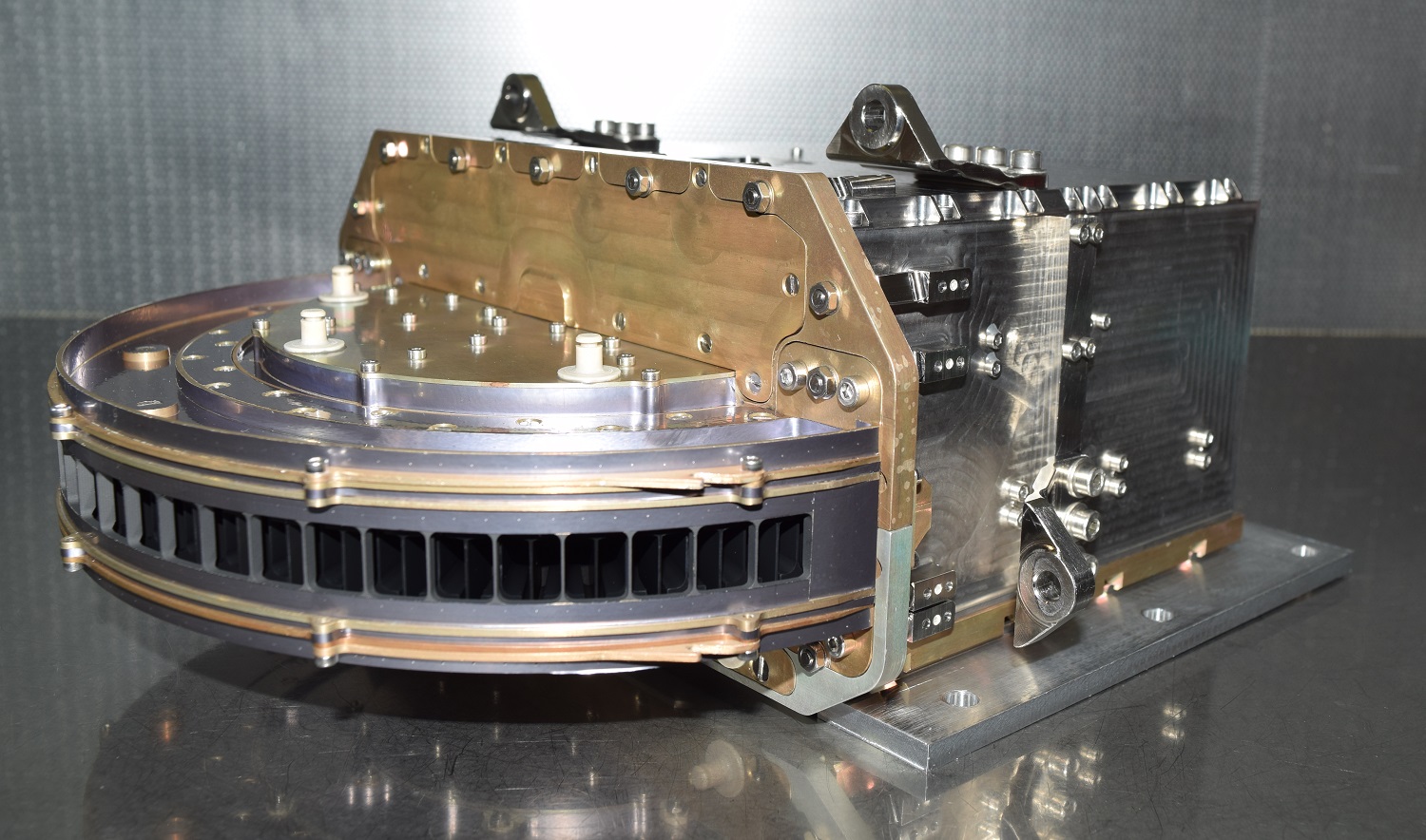
Figure 4. JNA Flight Model before delivery
Acknowledgements
Angèle Pontoni acknowledges support from the Swedish National Space Agency, grant 189/16.
References
[1] Grasset et al., 2013, JUpiter ICy moons Explorer (JUICE): An ESA mission to orbit Ganymede and to characterise the Jupiter system
[2] Barabash et al., 2009, Investigation of the Solar Wind–Moon Interaction Onboard Chandrayaan-1 Mission with the SARA Experiment
[3] Kazama et al., 2007, Development of an LENA instrument for planetary missions by numerical simulations
How to cite: Pontoni, A., Shimoyama, M., Asamura, K., Wurz, P., Wieser, M., and Barabash, S.: Calibration results of the Jovian Neutrals Analyzer onboard JUICE/PEP, Europlanet Science Congress 2021, online, 13–24 Sep 2021, EPSC2021-377, https://doi.org/10.5194/epsc2021-377, 2021.
Coulomb drag propulsion taps momentum from a natural plasma stream to generate propellantless low-thrust propulsion for a spacecraft. The plasma is attached to by means of a long, thin, charged metallic tether. The tether's electrostatic field deflects the motion of streaming plasma ions and transfers momentum from them. The technique can be applied in the solar wind (i.e., outside Earth's magnetosphere) to produce general-purpose interplanetar propulsion. This application is called the electric solar wind sail (E-sail). It can also be applied in low Earth orbit (LEO) to brake the satellite's orbital motion. Here the relevant plasma stream is the ram flow of the ionosphere due to the satellite's orbital motion. This application is called the plasma brake and it is useful for satellite deorbiting for mitigating the growing problem of orbital debris.
Here we report on progress of two CubeSat missions (FORESAIL-1 and ESTCube-2) that are under construction for measuring the Coulomb drag effect in LEO. Both are scheduled to fly in 2022. Both satellites deploy up to 300 m long tether, charge it up by a high-voltage source and measure the resulting Coulomb drag. The satellites are slowly spinning and the tether is tightened by the centrifugal force. The tether is deployed from a reel which is rotated slowly by an electric motor. Both satellites use negative tether polarity, which is the case relevant for the plasma brake. ESTCube-2 contains, in addition, a positive mode experiment which is relevant for the E-sail. The plasma environment in LEO differs from the solar wind, so the measured positive mode Coulomb drag must be scaled to yield a prediction of the strength of the E-sail effect in the solar wind.
The Coulomb drag is measured by two independent methods. In the first method we set the tether voltage on and off in sync with the satellite's rotation and thereby accumulate a change of the system's angular momentum. The Coulomb drag is inferred from the measured change of the spin rate per time unit. In the second method we estimate Coulomb drag from the speeded-up lowering of the satelllite's orbital altitude.
The presentation is a status report of the technical progress of these two Coulomb drag CubeSat missions; FORESAIL-1 and ESTCube-2.
How to cite: Janhunen, P., Toivanen, P., Kivekäs, J., Meskanen, M., and Polkko, J.: FORESAIL-1 and ESTCube-2 Cubesat experiments of Coulomb drag propulsion, Europlanet Science Congress 2021, online, 13–24 Sep 2021, EPSC2021-96, https://doi.org/10.5194/epsc2021-96, 2021.
The LONSCAPE - Light Optical NephelometerSizer and Counter for Aerosols in Planetary Envi-ronments (Renard et al., 2020) has been proposed asa concept combining a particle counter with a neph-elometer at several phase angles to characterize thescattering function and obtain precise aerosol prop-erties (see Figure 1).
LONSCAPE is currently considered as part ofthe science payload of a balloon designed to flyin the Venusian atmosphere (Baines et al., 2021).LONSCAPE has also been proposed to be partof the science payload of several Saturn descentprobe concepts submitted to the ESA M4 and M5calls (Mousis et al., 2016). This instrument is alsoconsidered as part of the science payload of an ESAconcept of ice giant probe to be carried by a NASAspacecraft (Mousis et al., 2018).
There are currently two major improvementsunder investigation that could be included to theinstrument’s design.
The first major improvement is the reduction ofthe wavelength at which the instrument operates(650→405nm). Such a change would allow thedetection of particles as small as∼0.1μm.Detectors tend to be less efficient towards theUV, but the light scattered by diffusion is directlyproportional to the ratiod/λ, withdthe particlediameter. This leads to more flux recovered towardsthe blue than in the red, even accounting fordetector efficiency (see Figure 2).
The second improvements concerns the shape ofthe beam. Making use of a thin nappe rather thana dot will increase the counting accuracy by (i) in-creasing the chance a particle will hit the beam, and(ii) reducing the time it takes to cross it.Both of these points play in favor of counting thesmaller, more numerous, particles. This modificationis quite favorable to be included to LONSCAPE, as itcould significantly enhance its detection capabilitiesfor minimal hardware changes.
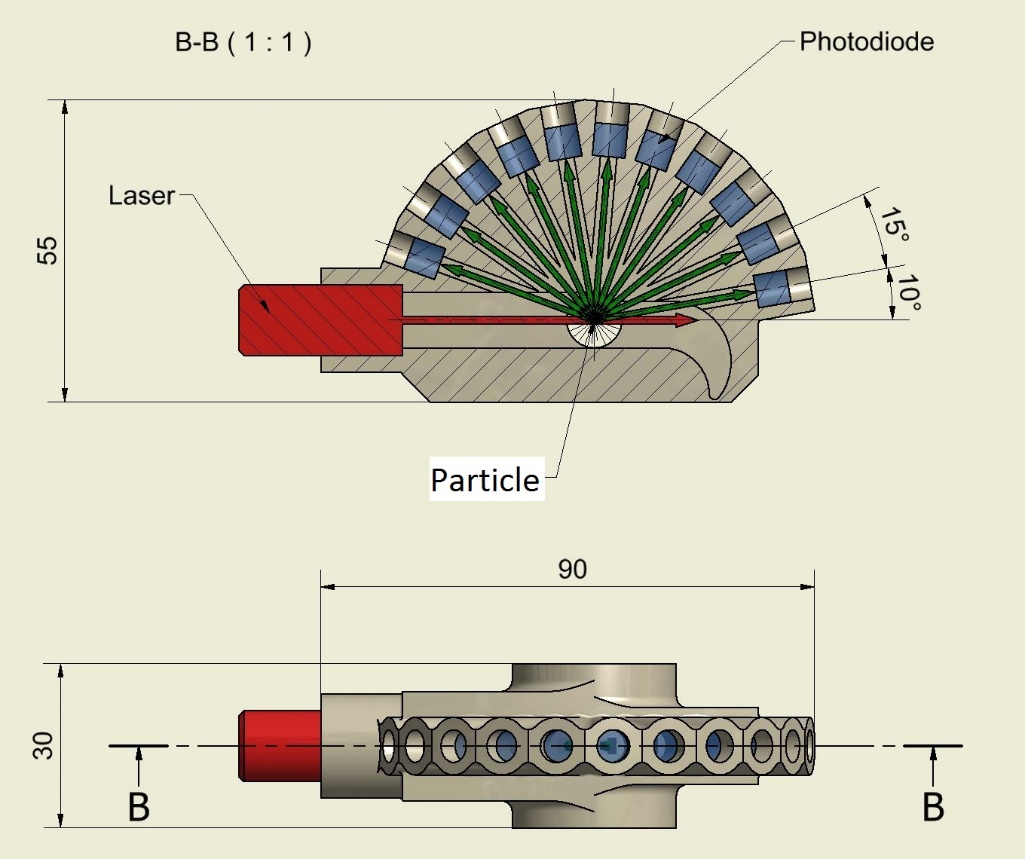
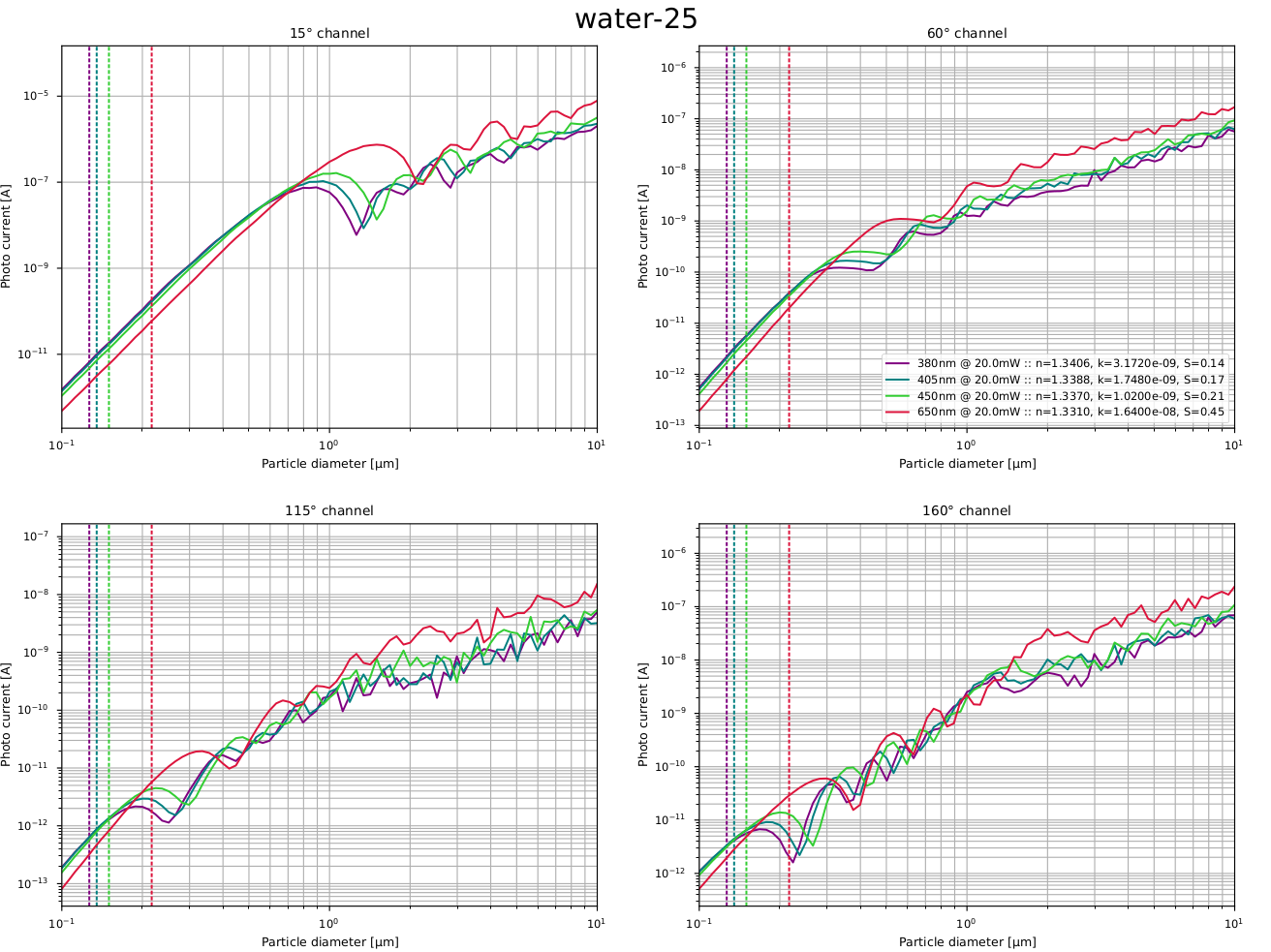
How to cite: Vivien, H., Renard, J.-B., Olivier, M., and Nicolas, V.: LONSCAPE: Light Optical Nephelometer Sizer and Counter for Aerosols in Planetary Environments, Europlanet Science Congress 2021, online, 13–24 Sep 2021, EPSC2021-242, https://doi.org/10.5194/epsc2021-242, 2021.
Please decide on your access
Please use the buttons below to download the presentation materials or to visit the external website where the presentation is linked. Regarding the external link, please note that Copernicus Meetings cannot accept any liability for the content and the website you will visit.
Forward to presentation link
You are going to open an external link to the presentation as indicated by the authors. Copernicus Meetings cannot accept any liability for the content and the website you will visit.
We are sorry, but presentations are only available for users who registered for the conference. Thank you.
Please decide on your access
Please use the buttons below to download the presentation materials or to visit the external website where the presentation is linked. Regarding the external link, please note that Copernicus Meetings cannot accept any liability for the content and the website you will visit.
Forward to session asset
You are going to open an external link to the asset as indicated by the session. Copernicus Meetings cannot accept any liability for the content and the website you will visit.
We are sorry, but presentations are only available for users who registered for the conference. Thank you.

